Text

Garuda Karaweik / गरुड ကရဝိက်
The image of an eagle devouring a snake is a national symbol of Mexico, based on an ancient prophecy fulfilled by the founding of Tenochtitlan in 1325. In Hindu, Buddhist, and Jain mythology, the garuda गरुड is a shapeshifting eagle deity, divine mount of Vishnu, and avid consumer of the nāga नाग (serpent deity). The garuda also appears as a national emblem in India, Thailand, and Indonesia.
3 notes
·
View notes
Text

Ganbatte Gombangdae / がんばって 곰방대
Korea has a very high rate of smokers due to its mandatory military service, Neo-Confucian cultural roots, excessive work schedule, and a favorable climate, soil, and economy for tobacco cultivation. Smoking was so prevalent during the latter half of the Joseon dynasty, even the tigers, rabbits, and magpies in folk art are portrayed with long gombangdae pipes and tobacco pouches.
0 notes
Text
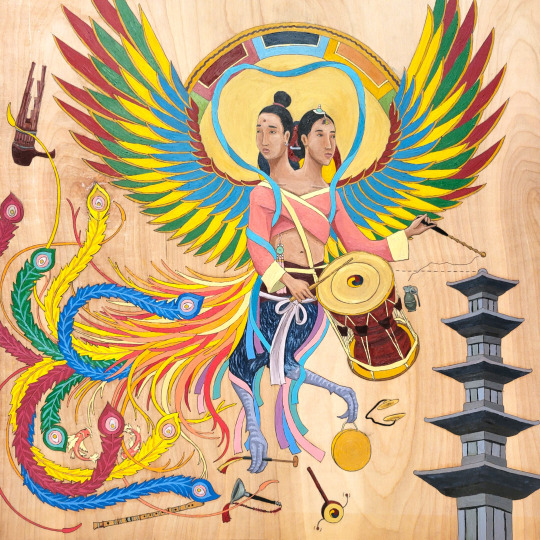
Kalaviṅka Gongmyeongjo / कलविङ्क 공명조
These human-headed, bird-bodied mythical creatures are Buddhist adaptations of the ancient Roman harpy, ancient Greek siren, and ancient Egyptian ba-bird. The Korean gongmyeongjo has two heads, which can also be found on medieval bird iconography from Central Asia, the Middle East, and Eastern Europe.
#kalavinka#gongmyeongjo#inmyeonjo#minhwa#korean art#buddhist art#harpy#siren#ba bird#gugak#oil on wood
3 notes
·
View notes
Text

Ajumma 24/7
In Korea, the pop-up food stalls, snack carts, and tent bars that cater to evening commuters are known as pojangmacha / 포장마차 (“covered wagons”). Many are unregistered, makeshift operations staffed by ajummas (older aunties), as there are far fewer employment opportunities for rural-born elder generations in Korea’s urban, industrial post-war economy.
2 notes
·
View notes
Text
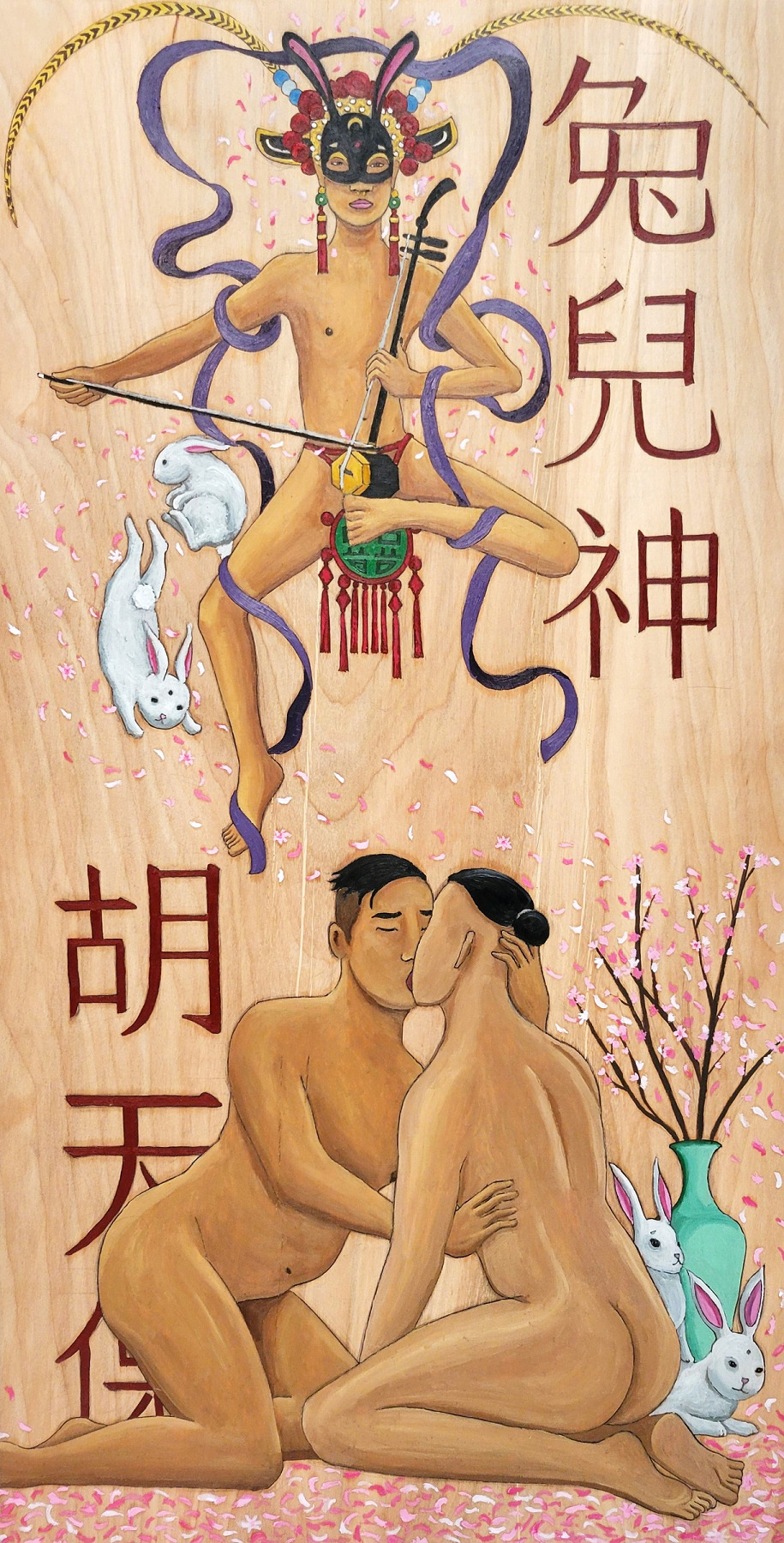
Tu'er Shen the Rabbit Deity, Patron Saint of Gay Romance
This benevolent guardian of the queer community is revered by Hokkien / Min Chinese people in Fujian, Taiwan, Lingnan, and throughout Southeast Asia. Since the 18th-century, the existence of most temples and shrines in this region have been kept secret to protect followers from government suppression, discrimination, and criminalization.
11 notes
·
View notes
Text

They Killed Queen Min and Hacked Off Our Hair (Portrait as Joseon ancestor during 단발령 / Short Hair Ordinance of 1895)
All of our kin in Korea still have their heads shaved bare during their compulsory military service as young adults. Our grandfather's great-grandfathers' would have been the last generation to wear a 상투 sangtu, a standard-issue topknot that died by tantō blade alongside Queen Min and Korea's last unified, autonomous period (1392–1897). Perhaps uncoincidentally, the 丁髷 chonmage (Japanese topknot) went extinct a few years earlier with the Dampatsurei Edict of 1871 during the Meiji Restoration (there's always a J-wave ahead of a K-wave).
#minhwa#korean history#hallyu#queen min#korean art#asian art#topknot#chonmage#sangtu#oil on wood#korean wave
1 note
·
View note
Text
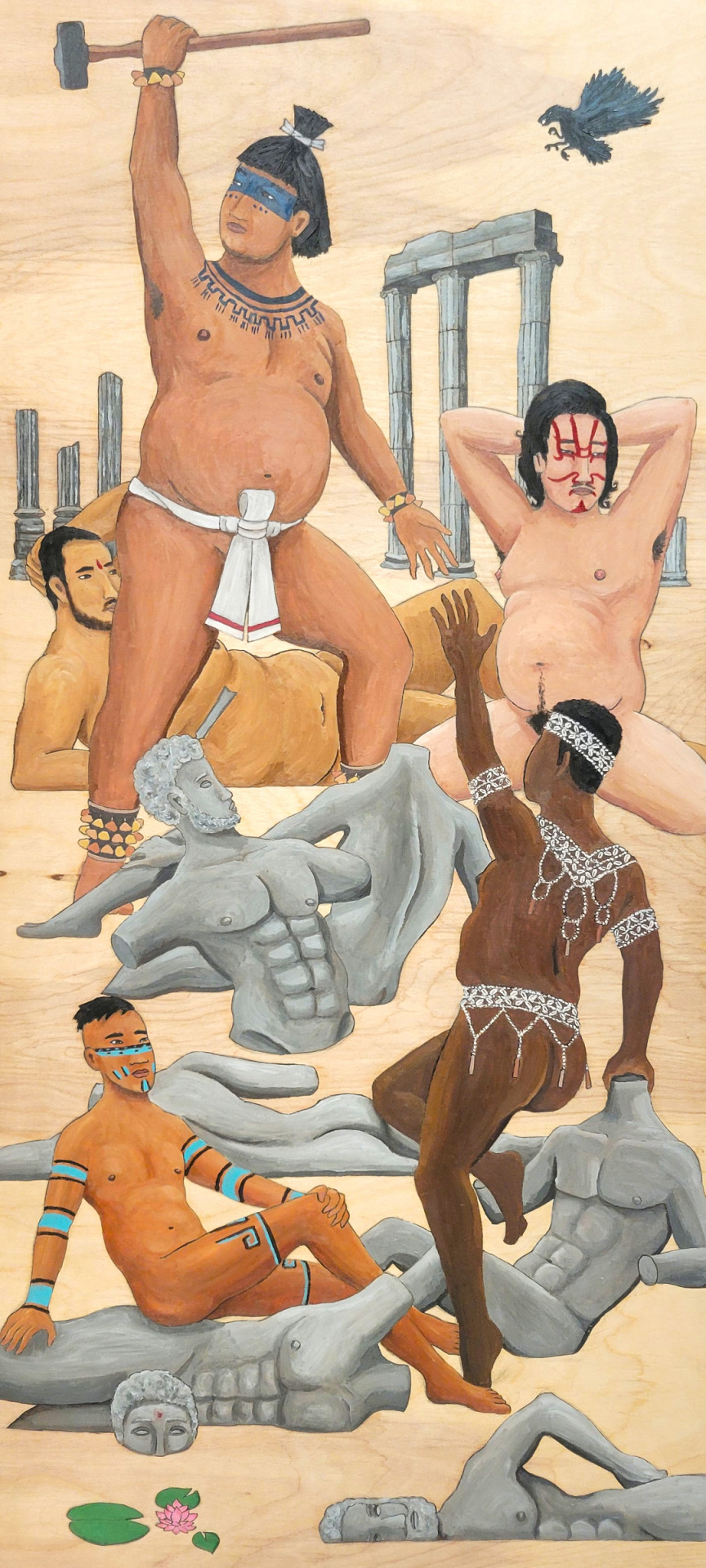
Brown Boy Beautiful and the Polychrome Antiquities
"Athens was never white but her statues, bereft of color, have conditioned the artistic sensibilities of Europe… the whole past has reached us colorless." (André Malraux). All of the marble sculptures, bronze statues, and ornamental architecture of ancient Greece and Rome were originally painted with many vibrant colors and elaborate patterns. Blank, unadorned sculptures became the norm of the western canon during the Renaissance, when the church sought to redefine its realm and its peoples under a single subcontinental identity built on shared classical foundations. This myth of paleness as divinity, purity, beauty, and authority is so pervasive that most of us absorb its message unknowingly as children and some of us never unlearn it (see Clark doll test, 1940 - present)
#greco roman#greco buddhist#classics#gay art#queer art#male gayze#oil on wood#western canon#art history
5 notes
·
View notes
Text


Descendants of the First Seafarers
Some of the ancestors of the native peoples of Madagascar, Malaysia, Indonesia, and the Pacific Islands (Micronesia, Melanesia, Polynesia) came from an ancient seaborne migration out of Taiwan and the Philippines (2200 BCE - 1250 CE). Cultural traditions still shared among these far-flung peoples today include tātau (tattoos), jade carving, stilt houses, and the cultivation of taro, pork, rice, coconuts, and yams.
#austronesian#pinoy#polynesian#melanesian#micronesian#aanhpi#maori#rapa nui#malagasy#oil on wood#tatau#pacific islander#size chart#gay art
15 notes
·
View notes
Text
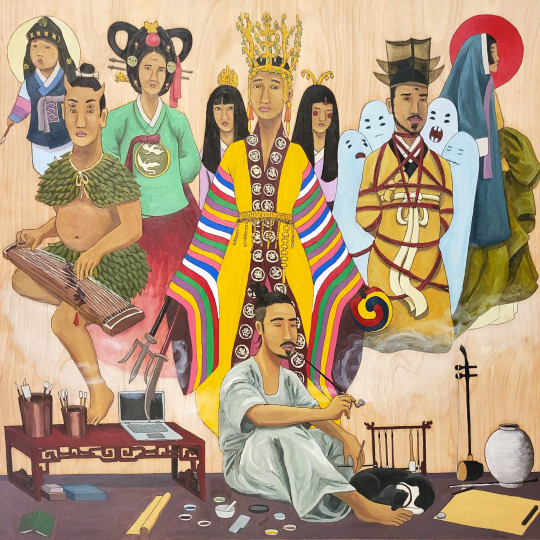
Gyopo Has a Smoke Before Painting Folk
Self-portrait with 19th-century Joseon painter's tools and an assortment of motherland artifacts, attire, and anachronisms
1 note
·
View note
Text

Unflappable Ajeossi and the War that Never Ended
the Korean Demilitarized Zone (1953 - present) is inaptly named, as it is the most heavily armed and least traversable international border in the world. Military service remains compulsory in both nations, and the population of military personnel between North and South Korea (15 million) is as large as the armed forces of India, China, Russia, and the United States combined (despite the latter four superpowers comprising 40% of the world's total population compared to the Koreas' 0.9%). Beginning in 2002, South Koreans were sometimes permitted to cross the DMZ to work in the Kaesŏng Industrial Zone or visit the Mount Kumgang Tourist Region, but both areas have since been closed off due to a deterioration of diplomatic relations.
0 notes
Text

Our Elders Enshrine the Ancestors as Jangseung and Dol Hareubang
the jangseung 장승 totem poles of Korea and the dol hareubang 돌 하르방 lava rock statues of Jeju are village guardians carved into humorous and terrifying caricatures of grandparents or folk deities. They are often placed on the outskirts of town near the sinmok 신목, a sacred tree (usually a zelkova serrata, Korean pine, or ginkgo biloba) with a sotdae 솟대 (carved duck on a pole) pointing away from the village to ward off ill-fortune, disease, and unwanted visitors.
1 note
·
View note
Text
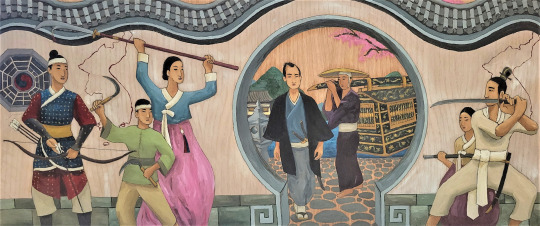
Ambush at the Magistrate's Moon Gate
From 1910 until 1945, the Korean peninsula was annexed by the Japanese Empire and became a colonial territory known as Chōsen. Korean language, culture, cuisine, currency, folk traditions, and family customs were suppressed for an entire generation, and several million Korean people were forcibly relocated to Japan, Manchuria, Russia, and Southeast Asia to address labor shortages in the empire's industrial and agricultural sectors during WWII. Koreans were also recruited as prison guards and comfort women for the military, which remains a sore subject among nationalist scholars and revisionist historians in the present. The end of the war did not result in Korean autonomy or reunification, instead Korea was subdivided along the 38th parallel N and occupied by more foreign authorities (the Soviet Civil Administration in the North and the United States Army Military Government in the South) preceding the Korean War and our modern unresolved state of affairs.
0 notes
Photo
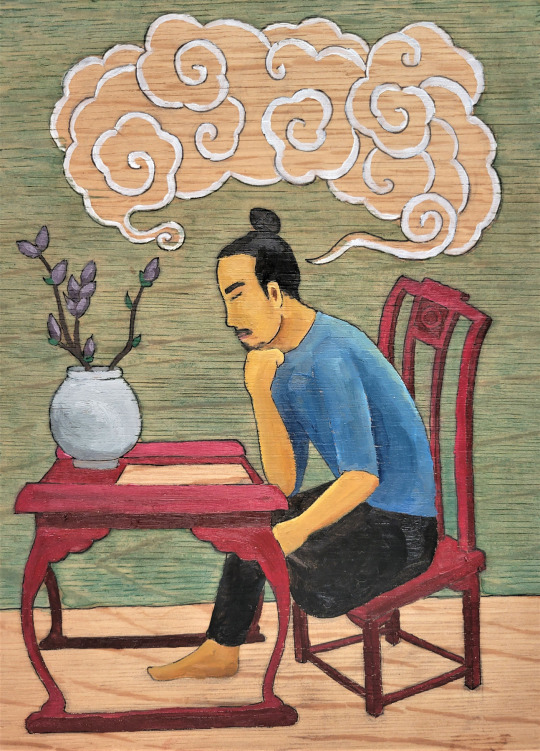
He Has Writer's Block - self-portrait inspired by 19th-century printmaker Tsukioka Yoshitoshi's "Kibi Daijin Seated at a Chinese Table."
https://www.inprnt.com/gallery/eirikswood/he-has-writers-block/
10 notes
·
View notes
Photo
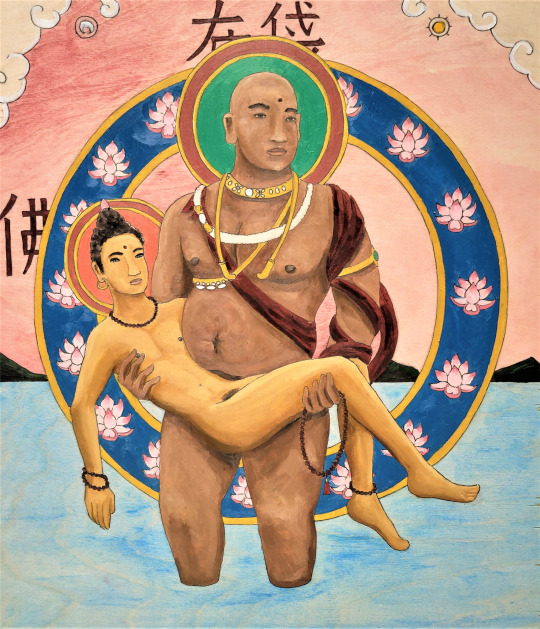
Buddha and Budai are Bodhi Buddies - portrait of Reclining Buddha and Laughing Buddha in La Pietà (Lamentation of Christ) pose
https://www.inprnt.com/gallery/eirikswood/buddha-and-budai-are-bodhi-buddies/
4 notes
·
View notes
Photo

Chan Fam Munjado and the Ten (12) Symbols of Longevity ( 陳家 문자도 / 십장생도 )
Our surname (陳) is shared among an estimated 100 million folks in southern China, southeast Asia, and the overseas diaspora. Munjado 문자도 is a Joseon (Korean) folk adaptation of Ming (Chinese) calligraphy (which was an absolute gauntlet of nightmares for this left-handed American). The ten (12) symbols of longevity 십장생도 are (spoiler alert): Pine tree 소나무, Sun 해, Crane 학, Water 물, Mountains 산, Clouds 구름, Deer 사슴, Turtle 거북, Bamboo 대나무, Stone 돌, Mushroom of Eternal Youth 영지, and the Peaches of Immortality 仙桃.
https://www.inprnt.com/gallery/eirikswood/chan-fam-munjado-and-the-ten-12-symbols-of-longevity/
3 notes
·
View notes
Photo

El Tamborilero / The Little Drummer Boy
The earliest known Asian-American settlement in the continental United States is Bayou Saint Malo, Louisiana (1763-1915) founded by deserting sailors and fugitive slaves from Manila, who were uniquely suited to thrive in the inhospitable and remote marshlands using indigenous shrimp fishing techniques and stilt houses from the Philippines. For 250 years (1565-1815) Spanish galleons crossed the Pacific Ocean trading luxury goods and forcibly recruiting and converting colonial subjects from Las Islas Filipinas and the Américas through the ports of Manila and Acapulco under the Viceroyalty of New Spain in México Tenochtitlán.
https://www.inprnt.com/gallery/eirikswood/el-tamborilero-the-little-drummer-boy/
#tamborilero#st malo#saint malo#bayou#aapi#asian art#pinoy#filipino#spanish galleon#manila galleon#oil on wood#drummer boy
16 notes
·
View notes
Photo
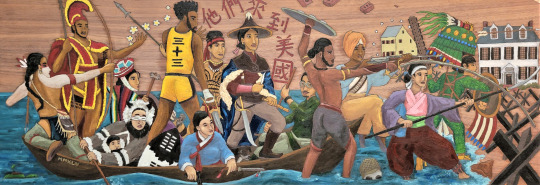



Hua Sheng Dun Crossing the Color Line (They Comin' to 'Murica) / 华盛顿横渡红线 (他們來到美國) - based on German-born Americana artist Emanuel Leutze's 1851 painting of George Washington on the eve of the Battle of Trenton (Christmas 1776), with lyrics from Neil Diamond's "America" (1981)
https://www.inprnt.com/gallery/eirikswood/hua-sheng-dun-crossing-the-color-line/
2 notes
·
View notes